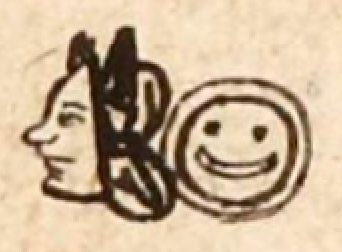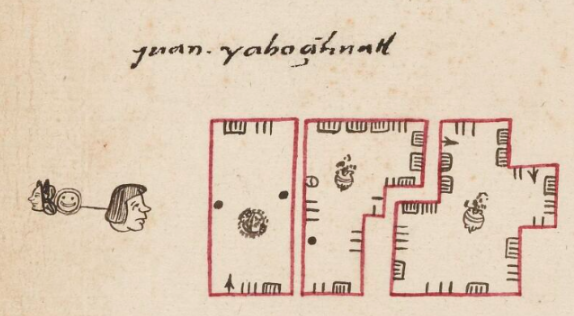Yaocihuatl (Verg12v)
This black-line drawing of the compound glyph for the personal name Yaocihuatl (perhaps "Warrior Woman” or "Combative Woman," attested here as a man’s name) shows a profile view of a woman's (cihuatl) head looking toward the viewer's left. Behind her head is a war shield (chimalli), a glyph typically used in names to conjure up war (yaotl) and to speak specifically of enemies or combatants. While this shield appears to have a smiling-face design, it could be a simplified cuexyo design. But perhaps more likely, it suggests European influence. Another example also comes from the Codex Vergara (11r), so these peculiar faces are the work of the same tlacuilo. The Codex Azcatitlan (Library of Congress, Image #30) shows Pedro de Alvarado (“Tonatiuh”) carrying a shield with a face in profile. In the latter, the face of the sun may be implied, given the use of suns as a heraldic charge in medieval and Renaissance art. See, for example, the fifteenth-century Book of Hours in France. Faces on European shields can also represent Christ or saints.
Stephanie Wood
Here is another man's name that includes some aspect of female gender. See some additional examples below. With regard to female combatants, while warriors in Nahua culture were usually men, women could participate in some war-related activities. Achichina was a legendary rebellion leader shortly after the Spanish invasion of Mexico. Malintzin carries a shield and sword in some scenes of the Lienzo de Tlaxcala. Women bared their bottoms and threw breast milk at the enemy in the history written and painted by Diego Durán. Finally, a woman waved her snake-shaped weaving baton (tzotzopaztli) like a weapon during a town's struggle to defend its territory, and by the eighteenth century, William B. Taylor (Drinking, Homocide, and Rebellion, 1979) found Indigenous women joined in riots and uprisings in equal or greater numbers to men.
Stephanie Wood
juan.yahoçihuatl
Juan Yaocihuatl
Stephanie Wood
1539
Jeff Haskett-Wood
cuexyoh, mujeres, género, guerra, combate, nombres de hombres

yao(tl), combatant, https://nahuatl.wired-humanities.org/content/yaotl
cihua(tl), woman, https://nahuatl.wired-humanities.org/content/cihuatl
Guerrera, o Mujer Combatiente
Stephanie Wood
Codex Vergara, folio 12r, https://gallica.bnf.fr/ark:/12148/btv1b84528032/f31.item.zoom
The non-commercial reuse of images from the Bibliothèque nationale de France is free as long as the user is in compliance with the legislation in force and provides the citation: “Source gallica.bnf.fr / Bibliothèque nationale de France” or “Source gallica.bnf.fr / BnF.” We would also appreciate a citation to the Visual Lexicon of Aztec Hieroglyphs, https://aztecglyphs.wired-humanities.org/.







